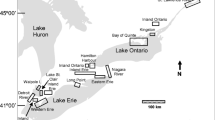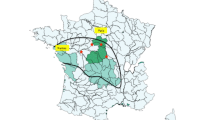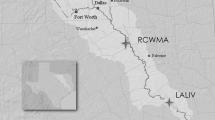Abstract
We investigated chlorinated hydrocarbon contaminants in aquatic mustelid species on the Fraser and Columbia Rivers of northwestern North America. Carcasses of river otter (Lutra canadensis) (N=24) and mink (Mustela vison) (N=34) were obtained from commercial trappers during the winters of 1990–91 and 1991–92. Pooled liver samples were analyzed for organochlorine pesticides, polychlorinated biphenyls (PCBs), including non-ortho congeners, polychlorinated dibenzo-p-dioxins (PCDDs) and dibenzofurans (PCDFs). Most samples contained detectable concentrations of DDE, PCBs, although there was substantial variability in patterns and trends among neighboring samples. Concentrations of DDE were in some mink and several otter samples from the lower Columbia River elevated (to 4700 μg/kg wet weight); excluding one mink sample from the Wenatchee area, mean DDE levels generally decreased between 1978–79 and 1990–92. PCBs were present in all samples. PCB concentrations in otter livers collected from the lower Columbia were ten-fold lower than measured a decade previously; nevertheless, a sample taken near Portland had a mean concentration of 1500 μg/kg, within a range of concentrations associated with reproductive effects in captive mink. Concentrations of 2,3,7,8-TCDD and TCDF were generally below detection limits, except for one otter collected near a pulp mill at Castlegar, on the upper Columbia, with 11 ng TCDD/kg in liver. Elevated concentrations of higher chlorinated PCDD/Fs, probably resulting from use of chlorophenolic wood preservatives, were found in both species; one otter sample from the lower Columbia had 2200 ng OCDD/kg. International TCDD toxic equivalent levels in mink (31 ng/kg) and otter (93 ng/kg) from the lower Columbia River approached toxicity thresholds for effects on reproduction in ranch mink.
Similar content being viewed by others
References
Addison, E. M., Fox, G. A. and Gilbertson, M. (eds.).: 1991, ‘Proceedings of the Expert Consultation Meeting on Mink and Otter’, Great Lakes Science Advisory Board's Ecological Committee Report to the International Joint Commission. March 5-6, 1991, Windsor, Ontario. 30 pp.
Ahlborg, U.G., Becking, G. C., Birnbaum, L. S., Brouwer, A., Derks, H. J., Feeley, M., Golor, G., Hanberg, A., Larsen, J. C., Liem, A. K. D., Safe, S. H., Schlatter, C., Wærn, F., Younes, M. and Yrjänheikki, E.: 1994, ‘Toxic equivalency factors for dioxin-like PCBs’, Chemosphere 28, 1049.
Anthony, R. G., Garrett, M. G. and Schuler, C.A.: 1993, ‘Environmental contaminants in bald eagles in the Columbia River estuary’, J. Wildl. Manage. 57, 10.
Aquametrix Research.: 1994, ‘Columbia River Integrated Environmental Monitoring Program (CRIEMP) – 1991 to 1993 interpretive report’, Aquametrix Research Ltd.'s Report to CRIEMP Coordinating Committee.
Aulerich, R. J. and Ringer, R. K.: 1970, ‘Some effects of chlorinated pesticides on mink’, Am. Fur Breeder 46, 10.
Aulerich, R. J., Ringer, R. K., Seagrin, H. L. and Youatt, W. G.: 1971, ‘Effects of feeding coho salmon and other Great Lakes fish on mink reproduction’, Can. J. Zool. 49, 611.
Aulerich, R. J., Bursian, S. J. and Napolitano, A.C.: 1988, ‘Biological effects of epidermal growth factor and 2,3,7,8-tetrachlorodibenzo-p-dioxin on developmental parameters of neonatal mink’, Arch. Environ. Contam. Toxicol. 17, 27.
Blus, L. J. Henny, C. J., Stafford, C. J. and Grove, R. A.: 1987, ‘Persistence of DDT and metabolites in wildlife from Washington State orchards’, Archiv. Environ. Contam. Toxicol. 16, 467.
Champoux, L.: 1996, ‘PCBs, dioxins and furans in hooded merganser (Lophodytes cucullatus), common merganser (Mergus merganser) and mink (Mustela vison) collected along the St. Maurice River near La Tuque, Quebec’. Environ. Pollut. 92, 147.
Cooke, A. S.: 1975, ‘Pesticides and eggshell formation’. Symp. Zool. Soc. London 35, 339.
Dwernychuk, L.W., Boivin, T. G. and Bruce, G. S.: 1993, ‘Fraser and Thompson Rivers dioxin/ furan trend monitoring program 1992 – final report’. Hatfield Consultant's Ltd.,West Vancouver, B.C., Canada.
Elliott, J. E., Martin, P. A., Arnold, P. W. and Sinclair, P. H.: 1994, ‘Organochlorines and reproductive success of birds in orchard and non-orchard areas of British Columbia, 1990-1991’. Arch. Environ. Contam. Toxicol. 26, 435.
Elliott, J. E., Whitehead, P. E., Martin, P. A., Bellward, G. D. and Norstrom, R. J.: 1996a, ‘Persistent pulp mill pollutants in wildlife’. in: Servos, M. R., Munkittrick, K. R., Carey, J. H. and Van Der Kraak, G.D. (eds.): Environmental Fate and Effects of Pulp and Paper Mill Effluents. St. Lucie Press, Delray Beach, FL. pp. 297–314.
Elliott, J. E., Norstrom, R. J., Lorenzen, A., Hart, L. E., Philibert, H., Kennedy, S. W., Stegeman, J. J., Bellward, G. D. and Cheng, K. M.: 1996b, ‘Biological effects of polychlorinated dibenzo-pdioxins, dibenzofurans, and biphenyls in bald eagle (Haliaeetus leucocephalus) chicks’. Environ. Toxicol. Chem. 15, 782.
Elliott, J. E., Machmer, M., Henny, C. J., Wilson, L.K. and Norstrom, R. J. ‘Contaminants in Ospreys from the Pacific Northwest: I. Trends and patterns in polychlorinated dibenzo-p-dioxins and dibenzofurans in eggs and plasma’, Archiv. Environ. Contam. Toxicol.(submitted).
Ford, C. A., Muir, D. C. G., Norstrom, R. J., Simon, M. and Mulvihill, M. J.: 1993, ‘Development of a semi-automated method for non-ortho PCBs: application to Canadian Arctic marine mammal tissues’. Chemosphere 26, 1981.
Hakansson, H., Manzoor, E. and Ahlborg, U. G.: 1992, ‘Effects of technical PCB preparations and fractions thereof on vitamin A levels in the mink (Mustela vison)’. Ambio 21, 588.
Hartsough, G. R.: 1965, ‘Great Lakes fish now suspect as mink food’. Am. Fur Breeder 38, 24.
Heaton, S. N., Bursian, S. J., Giesy, J. P., Tillitt, D. E., Render, J. A., Jones, P. D., Verbrugge, D. A., Kubiak, T. J. and Aulerich, R. J.: 1995, ‘Dietary exposure of mink to carp from Saginaw Bay. I. Effects on reproduction and survival and potential risks to wild mink populations’. Arch. Environ. Contam. Toxicol. 28, 334.
Henny, C. J., Blus, L. J., Gregory, S. V. and Stafford, C. J.: 1981, ‘PCBs and organochlorine pesticides in wild mink and river otters from Oregon’. in: Chapman, J. A. and Pursley, D. (eds.). Worldwide Furbearer Conference Proceedings, Vol. 3., from conference held Aug. 3-11, 1980, Frostburg, Maryland. pp. 1763–1780.
Hochstein, J. R., Aulerich, R. J. and Bursian, S. J.: 1988, ‘Acute toxicity of 2,3,7,8-tetrachlorodibenzo-p-dioxin to mink’. Archiv. Environ. Contam. Toxicol. 17, 33.
Jönsson, C. J., Lund, B. and Brandt, I.: 1993, ‘Adrenocorticolytic DDT-metabolites: studies in mink, Mustela vison, and otter, Lutra lutra’. Ecotoxicology 2, 41.
Kruuk, H. and Conroy, J.W. H.; 1996, ‘Concentrations of some organochlorines in otters (Lutra lutraL.) in Scotland: implications for populations’. Environ. Pollut. 92, 165.
Kuehl, D. W., Butterworth, B. C., DeVita, W. and Sauer, C. P.; 1987, ‘Environmental contamination by polychlorinated dibenzo-p-dioxins and dibenzofurans associated with pulp and paper mill discharge’. Biomed. Environ. Mass Spectrosc. 14, 443.
Leonards, P. E. G., Smit, M. D., de Jongh, A.W. J. J. and van Hattum, B.: 1994, ‘Evaluation of doseresponse relationships for the effects of PCBs on the reproduction of mink (Mustela vison)’. Institute for Environmental StudiesVrije Universiteit, Amsterdam. Report No. R-94/6: 50 pp.
Leonards, P. E. G., de Vries, T. H., Minnaard, W., Stuijfzand, S., de Voogt, P., Cofino, W. P., van Straalen, N. M. and van Hattum, B.: 1995, ‘Assessment of experimental data on PCB-induced reproduction inhibition in mink, based on an isomer-and congener-specific approach using 2,3,7,8-tetrachlorodibenzo-p-dioxin toxic equivalency’. Environ. Toxicol. Chem. 14, 639.
Leonards, P. E. G., Zierikzee, Y., Brinkman, U. A. T., Cofino, W. P., van Straalen, N. M. and van Hattum, B.: 1997, ‘The selective dietary accumulation of planar polychlorinated biphenyls in the otter (Lutra lutra)’. Environ. Toxicol. Chem. 16, 1807.
MacDonald, D. D., Ikonomou, M. G., Rantalaine, A-L., Rogers, I. H., Sutherland, D. and Van Oostdam, J.: 1997, ‘Contaminants in white sturgeon (Acipenser transmontanus) from the upper Fraser River, British Columbia, Canada’. Environ. Toxicol. Chem. 16, 479.
Mah, F. T. S., MacDonald, D. D., Sheehan, S. W., Tuominen, T. M. and Valiela, D.: 1989, ‘Dioxins and furans in sediment and fish from the vicinity of ten inland pulp mills in British Columbia’. Environment Canada Inland Waters Report, Pacific and Yukon Region, Vancouver, B.C. 77 pp.
Mason, C. F.: 1989, ‘Water pollution and otter distribution: a review’. Lutra 32, 97.
Mason, C. F. and O'sullivan, W. M.: 1992, ‘Organochlorine pesticide residues and PCBs in otters (Lutra lutra) from Ireland’. Bull. Environ. Contam. Toxicol. 48, 387.
McHattie, B., Taylor, M., Hoysak, D., Seburn, C., Seburn, D., Dennis, D., Bishop, C. A., Ewins, P. J. and Weseloh, D. V.: 1995, ‘Habitat rehabilitation in the Great Lakes: techniques for enhancing biodiversity’. Canadian Wildlife Service, Environmental Conservation Branch – Ontario Region, Environment Canada. Toronto, ON. 102 pp.
Melquist, W. E. and Hornocker, M. G.: 1983, ‘Ecology of river otters in west central Idaho’. Wildl. Monogr. 83, 1.
Newton, I., Wyllie, I. and Asher, A.: 1992, ‘Mortality from the pesticides aldrin and dieldrin in British sparrowhawks and kestrels’. Ecotoxicology 1, 31.
Norstrom, R. J. and Simon, M.: 1991, ‘Determination of specific polychlorinated dibenzo-p-dioxins and dibenzofurans in biological matrices by gel-permeation/ carbon chromatography and gas chromatography/ mass spectrometry’. in: Rappe, C. and Buser, H. R. (eds.). Environmental Carcinogen-Methods of Analysis and Exposure Measurement.Vol. 11, Polychlorinated Dibenzodioxins and Dibenzofurans.World Health Organization, International Association for Research on Cancer, Lyon, France.
Norstrom, R. J., Simon, M. and Mulvihill, M. J.: 1986, ‘A gel-permeation/ column chromatography cleanup method for the determination of CDDs in animal tissue’. Intern. J. Environ. Anal. Chem. 23, 267.
Norstrom, R. J., Simon, M., Muir, D. C. G. and Schweinsburg, R.: 1988, ‘Organochlorine contaminants in Arctic marine foodchains: identification, geographical distribution and temporal trends in polar bears’. Environ. Sci. Technol. 22, 1063.
Olsen, P., Emison, B., Mooney, N. and Brothers, N.: 1992, ‘DDT and dieldrin: effects on resident Peregrine falcon populations in south-eastern Australia’. Ecotoxicology 1, 89.
O'shea, T. J., Kaiser, T. E., Askins, G. R. and Chapman, J. A.: 1981, ‘Polychlorinated biphenyls in a wild mink population’. in: Chapman, J. A. and Pursley, D. (eds.). Worldwide Furbearer Conference Proceedings, Vol. 3., from conference held Aug. 3–11, 1980, Frostburg, Maryland. pp. 1746–1752.
Parsons, A. H., Huntley, S. L., Ebert, E. S., Algeo, E. R. and Keenan, R. E.: 1991, ‘Risk assessment for dioxin in Columbia River fish’. Chemosphere 23, 1709.
Rinella, J. F., Hamilton, P. A. and McKenzie, S. W.: 1993, ‘Persistence of the DDT pesticide in the Yakima River basin, Washington. U.S’. Geological Survey Circular No. 1090. 24 pp.
Safe, S.: 1990, ‘Polychlorinated biphenyls (PCBs), dibenzo-p-dioxins (PCDDs), dibenzofurans (PCDFs) and related compounds: environmental and mechanistic considerations which support the development of toxic equivalency factors (TEFs)’. Crit. Rev. Toxicol. 21, 51.
Sanderson, J. T., Elliott, J. E., Norstrom, R. J., Whitehead, P. E., Hart, L. E., Cheng, K. M. and Bellward, G.D.: 1994, ‘Monitoring biological effects of polychlorinated dibenzo-p-dioxins, dibenzofurans, and biphenyls in great blue heron chicks (Ardea herodias) in British Columbia’. J. Toxicol. Environ. Health 41, 435.
Servos, M. R., Huestis, S. Y., Whittle, D. M., Van Der Kraak, G. J. and Munkittrick, K. R.: 1994, ‘Survey of receiving-water environmental impacts associated with discharges from pulp mills. 3. Polychlorinated dioxins and furans in muscle and liver of white sucker (Catostomus commersoni)’. Environ. Toxicol. Chem. 13, 1103.
Smit, M. D., Leonards, P. E. G., van Hattum, B. and de Jongh, A. W. J. J.: 1994, ‘PCBs in European otter (Lutra lutra) populations’. Institute for Environmental Studies, Vrije Universiteit, Amsterdam. Report No. R-94/7: 122 pp.
Smits, J. E. G., Haines, D. M., Blakley, B. R. and Wobeser, G. A.: 1996, ‘Enhanced antibody responses in mink (Mustela vison) exposed to dietary bleached-kraft pulp mill effluent’. Environ. Toxicol. Chem. 15, 1166.
Smits, J. E. G., Wobeser, G. A. and Schiefer, H. B.: 1995, ‘Physiological, reproductive and pathological effects of dietary bleached pulp mill effluent on mink (Mustela vison)’. Environ. Toxicol. Chem. 14, 2095.
Tillitt, D. E, Gale, R. W., Meadows, J. C., Zajicek, J. L., Peterman, P. H., Heaton, S. N., Jones, P. D., Bursian, S. J., Kubiak, T. J., Giesy, J. P. and Aulerich, R. J.: 1996, ‘Dietary exposure of mink to carp from Saginaw Bay. 3. Characterization of dietary exposure to planar halogenated hydrocarbons, dioxin equivalents, and biomagnification’. Environ. Sci. Technol. 30, 283.
Wilkinson, L.: 1990, ‘SYSTAT: The System for Statistics’. SYSTAT Inc., Evanston, IL.
Wilson, L. K., Elliott, J. E. and Whitehead, P. E.: 1996, ‘Chlorinated compounds in wildlife from the Fraser River basin’. Canadian Wildlife Service, Pacific and Yukon Region. Technical Report Series No. 251. 73 pp.
Wise, M. H., Linn, I. J. and Kennedy, C. R.: 1981, ‘A comparison of the feeding biology of mink Mustela visonand otter Lutra luta’. J. Zool. London 195, 181.
Wren, C. D.: 1991, ‘Cause-effect linkages between chemicals and populations of mink (Mustela vison) and otter (Lutra canadensis) in the Great Lakes basin’. J. Toxicol. Environ. Health 33, 549.
Rights and permissions
About this article
Cite this article
Elliott, J.E., Henny, C.J., Harris, M.L. et al. Chlorinated Hydrocarbons in Livers of American Mink (Mustela vison) and River Otter (Lutra canadensis) from the Columbia and Fraser River Basins, 1990–1992. Environ Monit Assess 57, 229–252 (1999). https://doi.org/10.1023/A:1005919725832
Issue Date:
DOI: https://doi.org/10.1023/A:1005919725832




